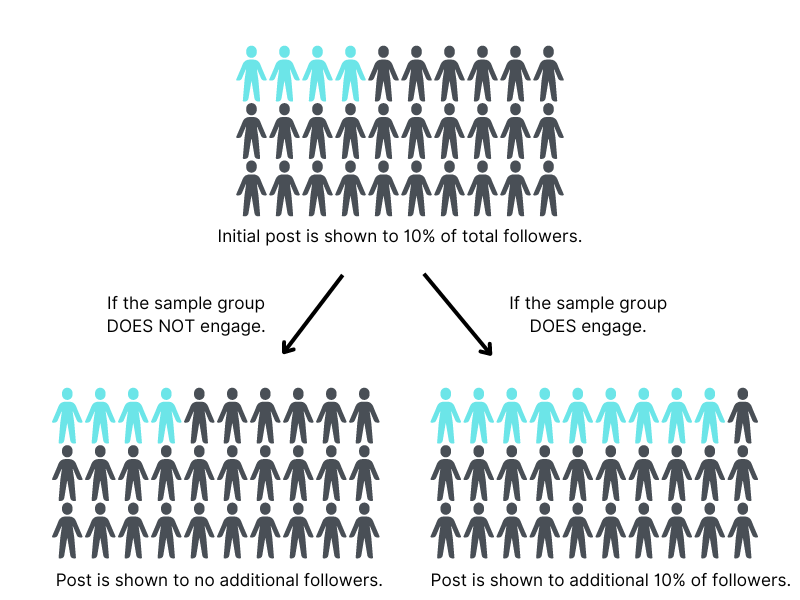Maximizing Your Social Selling Potential: Tracking the Right Metrics
It's easy to get lost in vanity metrics on social media. So let's focus on tracking the metrics that matter to social selling.
Social media has a special way of making us chase vanity metrics.
Like a throwback to high school popularity contests, social media provides quantifiable metrics highlighting our social standing amongst our peer group. Numbers that we can obsess over as we try to compare ourselves to what we think is “good” social performance.
Who has the most followers?
How many likes did I get?
How many views does the post have?
It’s easy to fall into the trap of focusing too much energy on trying to pump up these vanity metrics that social platforms show us.
But I’m here to remind you that you are not Kim Kardashian. You are not aiming to be the world's most popular social media influencer.
You are here to get profitable sales.
The goal of your social strategy is not to reach as many people as possible. Your goal is to reach as many of the right people as possible.
Why Follower Count Doesn’t Matter (That Much)
The “follower count” has long been the preferred vanity metric of social media.
How many followers you have on social media indicated how successful you were. More followers meant you were more popular!
But here’s the secret – your follower count doesn’t matter (that much).
Yes, it is a social signal. People will equate followers with authority.
Yes, it does impact the total reach of your content.
However, most social media platforms limit the amount of reach you can have to your follower list. No matter if you have 100 or 10,000 followers, only a portion of that list will organically see your content.
Follower Sampling
Social media platforms do what is called Follower Sampling. This is the practice of showing your posts to only a portion of your followers to sample the content’s engagement.
This was a BIG change that Facebook made in 2014. Previously, ALL of your followers saw all your posts. However, to encourage more paid advertising content, Facebook (and now essentially all social media sites) limits your organic reach by sampling your content to a small subset of your followers.
Every time you make a post, only a small sample of your followers will see it. If those sampled followers engage with your content by Liking, Commenting, or Reposting, then your post will be shown to an additional portion of your followers.

What does this mean? It means that most of your followers, who elected to subscribe to your content, will only see some of your posts. However, the more you increase your engagement, the more likely you will expand your organic reach to your audience.
One of the most significant implications of this is that the QUALITY of your followers is more important than the quantity.
You are better off having 500 followers who know you and are interested in your content than 5,000 random followers who are not engaged with you. Having too many “bad” followers can severely limit your ability to social sell.
As salespeople, you should know this instinctively. You’d rather have 10 qualified leads than 50 unqualified leads. This same principle applies to social networks as well.
So if we don’t care about follower count, what metrics should we care about?
The Metrics You Should Track
The metrics that do matter in your social selling strategy are the ones that directly drive your ability to expand your reach, build your authority, and generate more revenue.
Essentially, these are the digital version of the metrics you are already watching in the analog parts of your sales strategy.
Here are five metrics that I recommend you pay attention to:
1. Consistency in Posting
Your ability to consistently show up and publish content online is a significant factor in your success with a social strategy. It’s impossible to build a social following without regularly posting content online.
I recommend that everyone serious about social strategy develop a plan to consistently post new content at a frequency of 3-5 posts a week.
With weekly posting, you’ll stay in front of your network with content and insights that will build your authority and enable you to reach new audiences.
The metric to measure here is the number of posts per week that you are making. You can see this through the insights section on LinkedIn, or manually track yourself in a spreadsheet.
2. Content Engagement
The one vanity metric that does have some importance is engagement. This is how often your posts are commented on or “liked” by other users in your network. This is a signal that highlights the quality of your social content, and it’s ability to engage your audience.
More importantly, engagement enables you to start understanding what ideas or insights are most beneficial to your audience. In the digital world, we call this “Social Listening.” This is your ability to see what information your audience cares about by analyzing the content they are engaging with.
To track engagement, I recommend noting the posts with the highest engagement (likes, comments, etc.) and looking for trends in successful content.
- What was the topic? → Gives you insights into the type of information your audience wants.
- What was the format? → Gives you insight into the best medium to share information.
- Who was engaging? → Gives you insight into who your content resonates with.
Doing this regularly will allow you to continuously improve your social engagement with better content.
3. Conversations
A big part of what we are trying to do with a social strategy is striking up more conversations with prospective customers and relevant industry leaders. One of my favorite metrics is the number of conversations I’m facilitating through social channels.
A sign that you are running an effective social selling strategy is that people will WANT to talk to you. I get direct messages on LinkedIn daily from people asking me for advice related to social selling because they see me talking about it (see Consistency in Posting above).
Track both your inbound and outbound conversations every month. This will help you understand your social strategy's effectiveness in helping you start real conversations. Pay attention to what people say, specifically their pain points and the outcomes they seek.
4. Pipeline Growth
This leads us to the fourth, arguably most important, metric for you to track - pipeline growth. How is your social strategy helping you increase your revenue?
As you go about your social selling strategy, there will be two primary sources of direct revenue impact - 1) generating new leads and 2) nurturing existing deals.
To track new leads generated, I recommend adding a lead source in your CRM software, "Social Selling.” Any leads that come through your profile calls to action, social platform conversations, or your prospect explicitly said, “I saw your post on…” should be listed as a Social Selling sourced lead.
Tracking existing deals being nurtured is trickier. In this case, I recommend either manually or through automation, noting in your CRM when you see engagement from existing prospects on your social content.
5. Community Growth
And finally, let’s talk about community. Notice I say community, not followers. Your aim is not simply to pump up the number of people you are connected with, but to build a community of engaged prospects, customers, vendors, and industry professionals.
Measure your community with both the quantity and quality of your network. Your goal should be to add at least 20 new quality connections weekly.
Here are a few examples of people you should be connecting with:
- People whose posts you are engaging with.
- People who are in the same groups or associations as you.
- Your contacts at your existing accounts.
- As a follow-up to people you talk with at events/meetings.
- Other people in your industry who are active on social networks.
As you organically grow your community, you can leverage it as part of your social selling strategy. Turning community into opportunity by inviting people to meet, setting up referral partners, or simply promoting each other’s content.
From my experience, community is one of the most underrated benefits of social selling. While it doesn’t feel like a “sales” activity directly, a robust online community can pay dividends over time. Remember, it's not what you know; it's who you know.

So now that we’ve brought some clarity on what metrics matter to a social seller, let’s quickly break down your two action items for this week:
- Run Your Own Race - First and foremost, it’s time for a mindset shift. You are running your own marathon here. Don’t let the vanity metrics of social media platforms make you feel unsuccessful. Your goal is not to be the most popular, it’s to be the most effective.
- Track Your Metrics - Next, I want you to decide on 2-3 key social selling metrics that you can use to track your progress. You can use the suggestions above as inspiration, or determine your own. Either way, focus on tracking activities that will lead you to social selling success (not just to win popularity contests).
Ready to get started? Drop a comment below on how you will be tracking the success of your social selling strategy.
